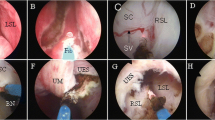Abstract
The objective of the study was to determine the efficacy of ultrasound-guided botulinum toxin type A (BTX-A) injection in the treatment of benign prostatic hyperplasia (BPH). In the 32 patients clinically diagnosed with BPH, 200 IU BTX-A was injected into five points at the lateral and middle lobes of the prostate under the guidance of ultrasound using a balloon dilatational device. The international prostate symptom score, quality of life score, maximum flow rate, post-void residual urine volume, prostate-specific antigen, and prostate volume were determined before treatment and at 1, 3, 6, and 12 months after treatment. All clinical symptoms and indicators were remarkably improved 1 month after the treatment and reached the optimal levels at 6 months post-treatment. This improvement of clinical parameters was maintained for a period of at least 1 year. Ultrasound-guided BTX-A injection was found to be safe and effective in the management of BPH.
Similar content being viewed by others
References
AUA Practice Guidelines Committee. (2003). AUA guideline on the management of benign prostatic hyperplasia: diagnosis and treatment recommendations. Journal of Urology, 170, 530–547.
Wasserman, N. F. (2006). Benign prostatic hyperplasia: a review and ultrasound classification. Radiologic Clinics of North America, 44, 689–710.
Clifford, G. M., & Farmer, R. D. T. (2000). Medical therapy for benign prostatic hyperplasia: a review of the literature. European Urology, 38, 2–19.
de La Rosette, J. J. M. C. H., Alivizatos, G., Madersbacher, S., Perachino, M., Thomas, D., Desgrandchamps, F., et al. (2001). EAU guidelines on benign prostatic hyperplasia (BPH). European Urology, 40, 256–264.
Lu-Yao, G. L., Barry, M. J., Chang, C. H., Wasson, J. H., & Wennberg, J. E. (1994). Transurethral resection of the prostate among medicare beneficiaries in the United States: time trends and outcomes. Urology, 44, 692–699.
Lim, S. K., & Quek, P. L. C. (2008). Intraprostatic and bladder-neck injection of botulinum A toxin in the treatment of males with bladder-neck dyssynergia: a pilot study. European Urology, 53, 620–627.
Welch, M. J., Purkiss, J. R., & Foster, K. A. (2000). Sensitivity of embryonic rat dorsal root ganglia neurons to clostridium botulinum neurotoxins. Toxicon, 38, 245–258.
Chuang, Y. C., & Chancellor, M. B. (2006). The application of botulinum toxin in the prostate. Journal of Urology, 176, 2375–2382.
Smith, C. P., & Chancellor, M. B. (2004). Emerging role of botulinum toxin in the management of voiding dysfunction. Journal of Urology, 171, 2128–2137.
Wyndaele, J. J., & Van Dromme, S. A. (2002). Muscular weakness as side effects of botulinum toxin injection for neurogenic detrusor overactivity. Spinal Cord, 40, 599–600.
Ding, X. D., Chen, H. X., Wang, W., et al. (2014). Effectiveness of the combination of botulinum toxin type A and bare-foot orthoses in treating lower limbs spasm in patients with hemiplegia after stroke. Chinese Journal of Physical Medicine Rehabilitation, 36, 349–352.
Flynn, M. K., Amundsen, C. L., Pemvich, M., Liu, F., & Webster, G. D. (2009). Outcome of a randomized, double-blind, placebo controlled trial of botulinum A toxin for refractory overactive bladder. Journal of Urology, 181, 2608–2615.
Author information
Authors and Affiliations
Corresponding author
Additional information
Xu-Dong Ding and Huan-Xian Chen have contributed equally to this work.
Rights and permissions
About this article
Cite this article
Ding, XD., Chen, HX., Xiao, HQ. et al. Treatment of Benign Prostatic Hyperplasia by Ultrasound-Guided Botulinum Toxin Type A Injection. Cell Biochem Biophys 73, 357–359 (2015). https://doi.org/10.1007/s12013-015-0606-8
Published:
Issue Date:
DOI: https://doi.org/10.1007/s12013-015-0606-8




